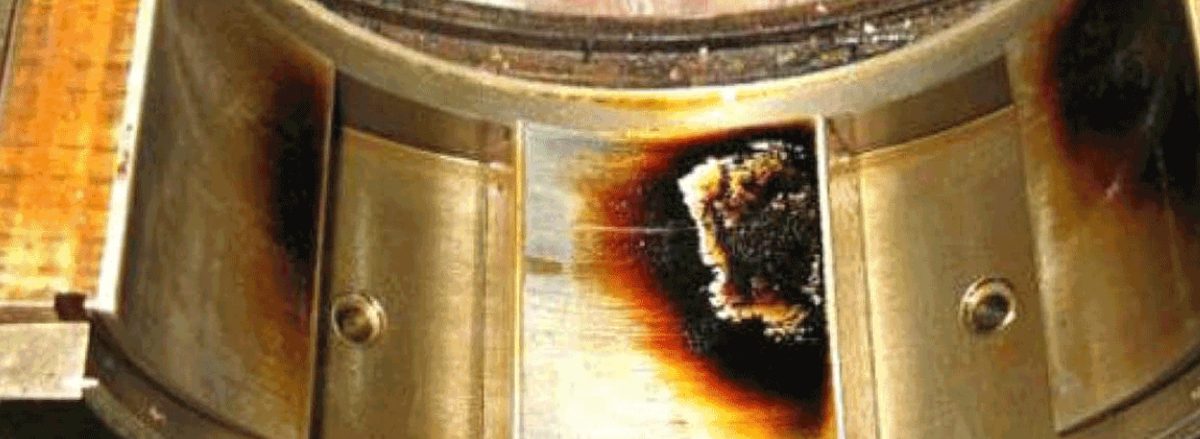Do you hate washing the dishes? Most of us do. It’s why we have dishwashers! But there are some messes even the dishwasher can’t clean, like when you burn something at the bottom of a pot or pan. A burn stain on your favorite pot or pan isn’t an easy fix. You have to let the stain soak or use strong cleaners to remove it, and you’re still probably going to need to do some extra hard scrubbing to restore your pan to its former glory.
What is varnish?
Cleaning a dirty pot or pan, especially one with a burn stain, is like dealing with varnish issues in an engine. There are a lot of complicated explanations for varnish, but it’s essentially lubricant degradation. The deposits that form in an engine or piece of machinery, known as varnish, are the signs of the lubricant breaking down and separating as the oil works through the machine. As a result, varnish deposits form on the surfaces of the equipment, eventually slowing things down or leading to equipment failure.
What is causing your lubricant degradation?
There are plenty of reasons your lubricants may begin to break down. The most popular reason is oxidation, which is when a chemical reaction between the air and the oil alters the makeup of the lubricant. But oxidation is a slow process and leads to more rigid deposit formations that are usually easy to remove with abrasives.
The deposits typically recognized as varnish are often caused by thermal stress. Thermal stress occurs when a heat source alters the lubricant quickly, just like when you burn food in your favorite pan. These deposits are much harder to clean and remove compared to oxidation.
Of course, oxidation and thermal stress are not the only reasons your lubricants may begin degrading. Contamination, system cleanliness, excess water, additive breakdown, poor base oils, and other chemical reactions may also contribute to the problem. Therefore, you must take appropriate preventive maintenance measures to stop your lubricants from degrading.
How can you avoid lubricant degradation?
You can choose the highest quality lubricants for your equipment, but as soon as you put them into your equipment or machinery, their chemical makeup will change. That’s just a fact. No matter how well maintained or clean your equipment is, dirt, grime, contaminants, and other chemicals are always left behind. That’s why regular oil analysis is so essential.
Here at Greg’s Petro, we offer an oil analysis program to help you stay on top of your equipment needs. We can teach you how to collect and send samples to our laboratory partner when you sign up. The lab will analyze your samples and look for signs of distress, degradation, or contamination. Based on their findings, they will offer personalized maintenance or lubricant recommendations based on your equipment’s needs. These recommendations are incredibly valuable because they consider how you use your machinery. If you are interested in this program and want to keep your fleet or equipment in optimal working condition, call your Greg’s Petroleum representative today!
How are varnish issues detected?
Several different specialized tests are used to detect varnish issues. These procedures aren’t always included in standardized testing protocols. However, they can provide valuable data that can help guide your maintenance programs. The two top tests for varnish are:
- Membrane Patch Colorimetric Method (MPC): MPC testing involves diluting an oil sample with a solvent and then filtering that sample through an ultra-fine white membrane. The color left behind on the membrane indicates potential issues and is measured on the CIELAB color scale. The remaining color saturation on the filter indicates the presence of varnish.
- Enhanced MPC method (iMPC): This test is a step above the MPC method, which is often criticized for not considering the temperature of the oil sample and repeatability issues. The iMPC method doesn’t involve diluting the oil sample with a solvent. Instead, the sample is passed through the membrane filter unaltered and allowed to dry. The color left behind is then measured on the same CIELAB color scale, which offers a more accurate representation of the total amount of varnish present in the sample since it wasn’t diluted.
Testing for varnish is a complicated process. These are just two testing procedures that may detect varnish levels in your equipment. Different techniques and testing methods may still provide valuable insights that can help guide your lubricant and maintenance programs.
How can I keep varnish deposits from forming?
We believe the best way to prevent varnish issues is to be proactive. While plenty of varnish removal tools and solutions exist, they are costly, time-consuming, and require significant equipment downtime. That’s not what’s best for your business. Being proactive about varnish issues starts with ordering the right lubricants and fuel supplies. Top-quality lubricants, like those from Chevron, work right out of the container.
Ideally, the lubricants you use should be derived from high-quality base oils with suitable additives to meet your equipment needs. Our team can work with you to find the right product. Our recommendations are always based on how you use your equipment and your needs. Ordering the right supplies and performing regular maintenance and oil analysis are the best ways to prevent varnish issues from occurring in the first place.
A recent survey from Machinery Lubrication found that 81% of lubrication professionals experience oil degradation problems due to varnish and oxidation. So, know that you’re not alone in dealing with these issues. Our team has the experience and knowledge to help you avoid varnish problems and deal with them as they come up. So, call us today, and let’s talk about how we can keep your equipment varnish-free!
